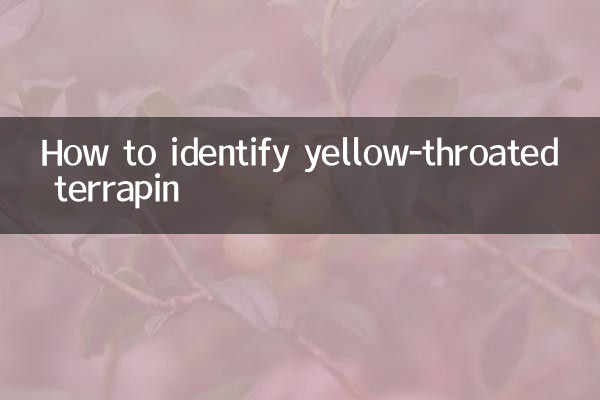How to identify yellow-throated terrapin
The yellow-throated turtle (Mauremys mutica) is a common freshwater turtle that is loved by many enthusiasts for its unique morphological characteristics and ornamental value. However, it is often confused with other similar turtle species on the market, making it difficult for consumers to distinguish. This article will combine the hot topics and hot content on the Internet in the past 10 days to give you a detailed introduction to the identification methods of yellow-throated water turtles to help you accurately identify this species.
1. Basic characteristics of the yellow-throated water turtle

Yellow-throated terrapins are mainly identified based on their appearance, color and markings. The following are its typical characteristics:
| feature | describe |
|---|---|
| head | The head is olive or yellow-green, and the throat is bright yellow, hence the name "yellow-throated". |
| carapace | The carapace is tan or dark brown, with slightly jagged edges and an obvious ridge in the center. |
| plastron | The plastron is yellow or light brown with black patches that are irregular in shape. |
| limbs | The limbs are grey-brown and have webbed toes, suitable for swimming. |
| tail | The tail is shorter, the male's tail is thicker and longer, and the female's tail is thinner and shorter. |
2. Comparison between the yellow-throated water turtle and similar turtle species
Common turtle species on the market that are similar to the yellow-throated turtle include Chinese tortoises, Brazilian turtles, etc. Here are their differences:
| Turtle species | head features | Carapace characteristics | Plastron characteristics |
|---|---|---|---|
| yellow-throated turtle | Throat is bright yellow | Tan, with a ridge in the center | yellow with black patches |
| Chinese tortoise | Head is grey-brown, no yellow throat | Dark brown, no ridges | Black with yellow edges |
| Brazilian turtle | Red or orange patches on the head | green with yellow stripes | yellow with black spots |
3. Gender identification of yellow-throated water turtle
The gender of the yellow-throated terrapin can be identified by the following characteristics:
| gender | feature |
|---|---|
| male | The tail is thick and long, and the cloaca is far away from the edge of the plastron; the plastron is slightly sunken. |
| female | The tail is thin and short, and the cloaca is close to the edge of the plastron; the plastron is flat. |
4. Breeding and protection of yellow-throated water turtle
The yellow-throated water turtle is a protected species, and you should pay attention to the following points when raising it:
1.water quality management: Yellow-throated aquatic turtles have high requirements for water quality. They need to keep the water clean and change the water regularly.
2.food choices: Mainly live bait such as small fish, shrimp, aquatic insects, etc. Turtle food can also be fed.
3.temperature control: The suitable water temperature is 25-30℃, and heating equipment is required in winter.
4.legal source: When purchasing, please confirm that the source of the turtle is legal and avoid purchasing wild individuals.
5. Recent hot topics and hot content
In the past 10 days, hot topics about the yellow-throated water turtle have mainly focused on the following aspects:
1.Reproduction Techniques of Yellow-throated Terrapin: Many enthusiasts have shared their successful experiences in artificial breeding.
2.Market price of yellow-throated terrapin: Prices have fluctuated greatly recently, so please be careful to identify authenticity.
3.Disease prevention and control of yellow-throated terrapin: Treatment methods for common diseases such as nail rot and white eye disease.
4.Conservation status of yellow-throated terrapin: Strengthen the protection of wild populations in many places.
Conclusion
The Yellow-throated Terrapin is a beautiful freshwater turtle. Through the introduction in this article, I believe you have mastered how to identify it. During the breeding and protection process, please be sure to abide by relevant laws and regulations to jointly maintain the living environment of this species.

check the details

check the details